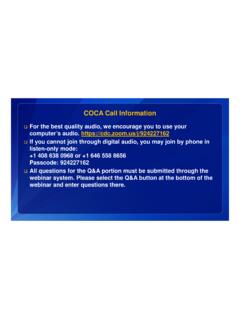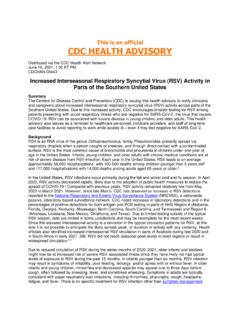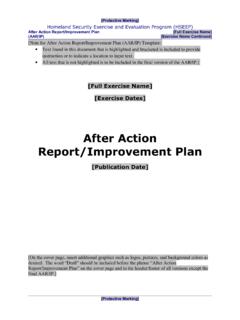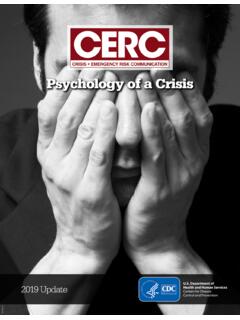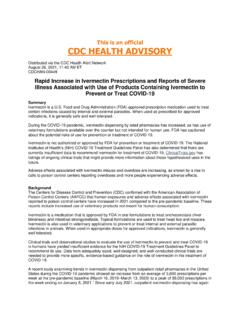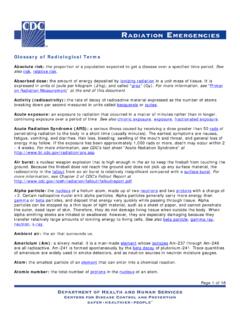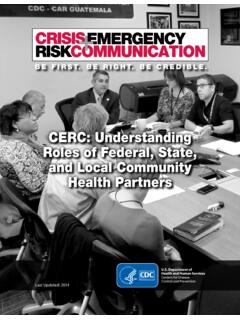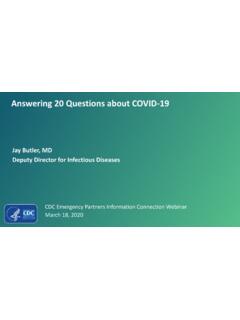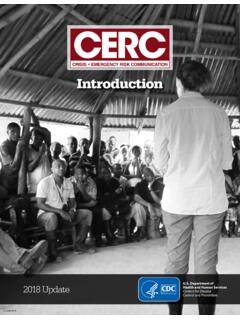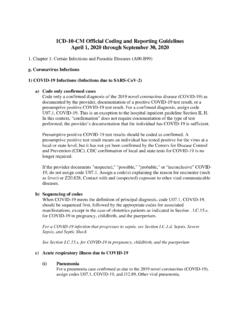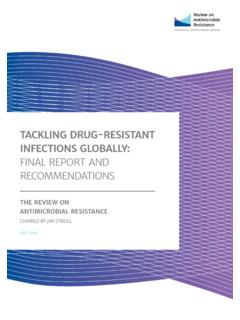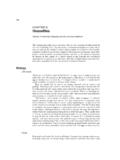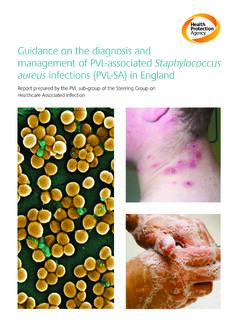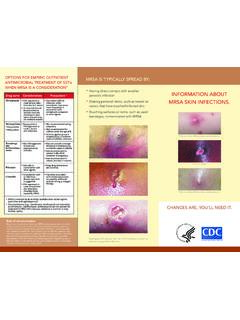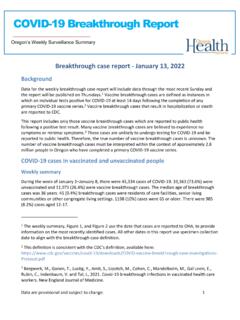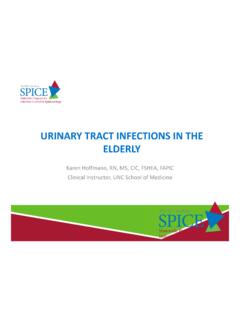Transcription of This is an official CDC HEALTH ADVISORY
1 This is an official CDC HEALTH ADVISORY . Distributed via the CDC HEALTH Alert Network Friday, December 24, 2021, 7:00 PM ET. CDCHAN-00460. Rapid Increase of Omicron Variant infections in the United States: Management of Healthcare Personnel with SARS-CoV-2 Infection or Exposure Summary Due to the increased transmissibility of the SARS-CoV-2 Omicron variant and concerns about potential impacts on the healthcare system, the Centers for Disease Control and Prevention (CDC) is updating recommendations to enhance protection for healthcare personnel, patients, and visitors, and ensure adequate staffing in healthcare facilities. The guidance is based on the limited information currently available about the Omicron variant and will be updated as needed as new information becomes available. Background On November 24, 2021, a new variant of SARS-CoV-2, (Omicron), was reported to the World HEALTH Organization (WHO).
2 Current COVID-19 vaccines are expected to protect against severe illness, hospitalizations, and deaths from infection with the Omicron variant. Omicron might cause more breakthrough infections than prior variants, and some studies have found lower effectiveness of the primary series of vaccines against infection (1-3). On December 1, 2021, the first case attributed to Omicron was reported in the United States. Omicron has now been reported in all 50 states. CDC has been working with state and local public HEALTH officials to monitor the spread of Omicron in the United States and has identified a rapid increase in infections consistent with what has been observed in other countries. Multiple large clusters of Omicron variant cases have demonstrated the rapid spread of the virus. Holiday-related travel and gatherings may further accelerate these trends. Plausible scenarios include steep epidemic trajectories that would require prompt public HEALTH action to prevent severe impacts on the HEALTH of individuals and healthcare systems.
3 The clinical severity profile of Omicron infection will strongly influence its impact on hospitalizations and deaths. Early data suggest Omicron infection might be less severe than infection with prior variants (3,4); however, reliable data on clinical severity remain limited (5). Even if the proportion of infections associated with severe outcomes is lower than with previous variants, a rapid, large increase in the number of infections could still result in many people with severe outcomes requiring medical care and hospitalization in a short period. Demand for ambulatory care, supportive care for treatment of mild cases, and staffing shortages resulting from work restriction of healthcare personnel with SARS-CoV-2 infection or with higher-risk exposures could also stress the healthcare system. Maintaining appropriate staffing in healthcare facilities is essential to providing a safe work environment for healthcare personnel and safe patient care.
4 CDC's mitigation strategies offer a continuum of options for addressing healthcare staffing shortages and are meant to be implemented sequentially. These strategies were updated on December 23, 2021. If conventional strategies cannot be sustained during a surge in cases, facilities may consider implementing contingency strategies, then crisis strategies, in an incremental manner. Facilities are best positioned to evaluate their own needs as to whether conventional, contingency, or crisis strategies are most appropriate at a given time. Consider options to address a healthcare surge by shortening the duration of work restrictions. When staffing shortages are anticipated, healthcare facilities and employers should plan and prepare to address these shortages in collaboration with staff leadership, human resources, and occupational HEALTH services. This can include adjusting staff schedules, hiring additional healthcare personnel, and rotating personnel to positions that support patient care activities.
5 It can also include modifications in practices for work restrictions of healthcare personnel who have had higher-risk exposures to SARS-CoV-2 or who have been infected with SARS-CoV-2, as described below. Conventional, contingency, and crisis strategies to mitigate staffing shortages are described in CDC guidance and are intended to allow flexibility to maintain adequate staffing for safe and effective patient care while minimizing the risk of SARS-CoV-2 transmission in healthcare facilities. Protecting the HEALTH and safety of healthcare personnel remains critical and includes ensuring the recommended personal protective equipment (PPE). is available and that healthcare personnel are trained to use it properly. Healthcare personnel with higher-risk exposure Personnel who have received all COVID-19 vaccine and booster doses as recommended by CDC. Under conventional strategies, asymptomatic healthcare personnel who have received all COVID-19 vaccine and booster doses as recommended by CDC do not need to be restricted from work if they have had a higher-risk exposure but do not have symptoms.
6 They should follow all recommended infection prevention and control practices and isolate immediately if they develop symptoms. Under conventional strategies, such personnel should be tested for SARS- CoV-2, per CDC guidance. Under contingency or crisis strategies, testing is not required, and the duration of quarantine may be shortened. Personnel who have not received all COVID-19 vaccine and booster doses as recommended by CDC. Under conventional conditions, asymptomatic healthcare personnel who have not received all COVID-19 vaccine and booster doses as recommended by CDC, and who have had a higher- risk exposure to SARS-CoV-2, can return to the workplace after day ten without testing, or facilities can limit the duration of work restriction under certain circumstances as outlined in CDC. guidance. Under contingency conditions such personnel can continue to work using a test-to- stay strategy under certain circumstances.
7 Under crisis conditions, such personnel can continue to work without testing as long as they remain asymptomatic. Healthcare personnel who are exposed should use well-fitting respiratory source control all times while in the facility and follow all conventional, contingency, and crisis strategies and follow all recommended infection prevention and control practices. Healthcare personnel with SARS-CoV-2 infection Under conventional conditions, healthcare facilities can allow asymptomatic healthcare personnel with SARS-CoV-2 infection, regardless of vaccination status, to return to work after seven days and a negative test in accordance with CDC guidance. For healthcare personnel who were symptomatic, fever should have resolved without medications, as detailed in Return to Work Criteria. Under contingency conditions, healthcare personnel with SARS-CoV-2 infection can return to work at five days, if asymptomatic, with facilities having the option to include a negative viral test in the criteria to return to work.
8 Under crisis conditions, such personnel can remain at work or can return to work at less than five days, if asymptomatic or mildly symptomatic, as a last resort, without testing. These healthcare personnel should wear a respirator or well-fitting facemask even when they are in non-patient care areas. Facilities should consider assigning these healthcare personnel to duties that do not include care of immunocompromised patients. Conventional work restrictions for healthcare personnel should not be shortened under certain circumstances. This includes healthcare personnel who are moderately to severely immunocompromised. Also, in the event of ongoing transmission within a facility that is not controlled with initial interventions, strong consideration should be given to using more stringent work restriction for healthcare personnel with higher-risk exposures. There might be other circumstances for which a jurisdiction's public HEALTH authority recommends these and additional precautions for directing healthcare personnel to follow work restrictions.
9 Recommendations for Healthcare Personnel Get all doses of COVID-19 vaccines, including additional and booster doses as recommended by CDC as well as influenza vaccine to protect yourself, your family, and your patients. Increase patient outreach efforts to recommend, encourage, and offer COVID-19 vaccination and boosters. Recommend that all healthcare personnel who are immunocompromised continue to practice all prevention measures to protect themselves against COVID-19 even if they have received all COVID-19 vaccines, additional and booster doses as recommended by CDC. When spending time in community settings, take all recommended steps to protect yourself and others from SARS-CoV-2 infection to decrease the risk of introducing new transmission into the healthcare setting. Recommendations for Healthcare Facilities and Systems and Nursing Homes Implement new CDC guidance for contingency and crisis conditions to shorten duration of work restrictions for healthcare personnel with SARS-CoV-2 infection and those who had a higher-risk exposure to SARS-CoV-2, when needed to alleviate healthcare staffing shortages and maintain a safe environment for patients, visitors, and healthcare personnel.
10 Recommend and offer COVID-19 vaccine and boosters to your staff and employees and establish policies to encourage uptake such as time off to get COVID-19 vaccinations and boosters. See resources at Workplace COVID-19 Vaccine Toolkit. Provide resources and support to assist healthcare personnel with stress and physical demands. Ensure that SARS-CoV-2 testing is performed with a test that can detect SARS-CoV-2. considering currently circulating variants. For more information, see SARS-CoV-2 Viral Mutations: Impact on COVID-19 Tests | FDA. For More Information Omicron Variant: What You Need to Know | CDC. Strategies to Mitigate Healthcare Personnel Staffing Shortages | CDC. Interim Guidance for Managing Healthcare Personnel with SARS-CoV-2 Infection or Exposure to SARS-CoV-2 | CDC. Interim Clinical Considerations for Use of COVID-19 Vaccines | CDC. CDC COVID Data Tracker References 1. Andrews N, Stowe J, Kirseborm F, et al.
